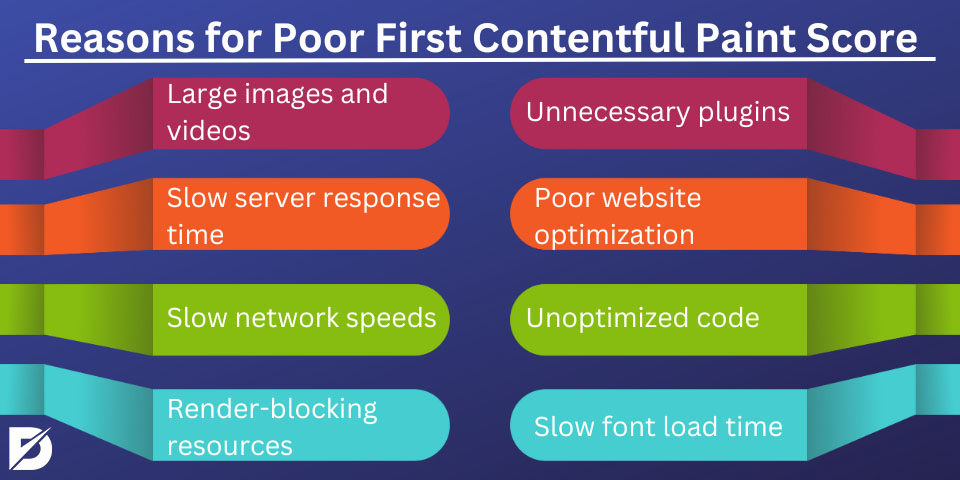As a web developer or website owner, you are well aware of the significance of page loading speed. Without a doubt, Google’s Lighthouse is one of the essential tools you use. At this point, the Lighthouse Performance report focuses on six metrics: Speed Index, Time to Interactive, Total Blocking Time, Cumulative Layout Shift, Largest Contentful Paint, and First Contentful Paint. Each measure evaluates a specific part of the webpage’s load time. Today, we’ll zoom in on the last one. It is crucial to ensure visitors enjoy a satisfactory user experience. Therefore, we would like to discuss this metric in great detail. First, we’ll answer the question, “What is FCP?” Next, we’ll discuss its importance in brief. Afterward, we’ll list the tools for measuring your website’s FCP score. Following that, we’ll list the primary reasons for poor FCP scores. Lastly, you can find some steps to improve your score.
What Is First Contentful Paint?
First Contentful Paint is one of the Core Web Vitals metrics that measures the duration of time between when a page is requested and when any content appears on the screen. In other words, it measures the duration between website access. Also, it measures the initial display of page elements, including images, text, non-white elements, logos, etc. You should also check the What is LCP article.
Why Is First Contentful Paint Important?
It is clear that FCP is a significant metric in measuring any website’s performance. Because it signifies when visitors can begin viewing the content on their screens. We know that this first impression of your website’s speed significantly impacts users’ experience, engagement, and, ultimately, conversion and bounce rates. If you want to know how to improve SEO with user experience factor, FCP is an important metric.
FCP offers valuable insights into a web page’s loading experience by measuring visitors’ duration to perceive visual content, including background graphics. A high FCP score indicates slower content loading times, which can prompt visitors to perceive the website negatively. Conversely, a low First Contentful Paint score implies quick content loading, leading to a better user experience and increased engagement.
What Is the Best FCP Score?
Before checking your FCP score with several tools, it is crucial to answer what is a good First Contentful Paint score. Based on their scoring system, Google rates FCP scores as good, need improvement, or poor. Therefore, as web developers or website owners, we need to ensure that our score falls within the good score range.
A good FCP score is achieved when the page loads within 0 to 1.8 seconds. If the page loads within 1.8 to 3 seconds, it needs improvement. A score above 3 seconds is considered poor. A good FCP score will increase your website’s SEO performance.
How to Measure First Contentful Paint
There are different methods to measure your FCP score, including both lab tests and field tools. To measure First Contentful Paint, there are several tools available, including:
- Lighthouse
- PageSpeed Insight
- Search Console
- Chrome DevTools
- Chrome User Experience Report (CrUX)
- WebPageTest
- GTmatrix
Reasons for Poor First Contentful Paint Score
One of the things we’ve learned is that a high score for FCP often indicates a slow page loading time. Now that a new question arises: Why do we have poor FCP scores? If you’re ready to dig in, here are some common reasons why your website might have a poor First Contentful Paint score:

- Large images and videos. When a webpage includes bulky images or video files, it can notably reduce the page’s loading speed, causing a higher FCP score.
- Slow server response time. When the server is slow to respond to a user’s request, it can result in an elevated FCP score. This can occur for various reasons, including an overwhelmed server, network congestion, or misconfigured server settings.
- Slow network speeds. A slow or faulty network connection can cause a webpage to load longer, leading to extended load times.
- Render-blocking resources. When a webpage has resources that must load before content can be displayed, such as scripts and stylesheets, it can cause the browser to wait.
- Unnecessary plugins and third-party scripts. An excessive amount of plugins and third-party scripts, such as social media widgets or analytics tracking codes, can increase the number of requests the browser sends. The more requests the browser sends, the longer it will result in a higher FCP score.
- Poor website optimization. Website assets that are not optimized efficiently, such as JavaScript and CSS files, can cause rendering delays on a page and result in a higher FCP score.
- Unoptimized code. If a website’s code is bloated or unoptimized, it can significantly slow the loading time, affecting the First Contentful Paint score.
- Slow font load time. When a webpage contains numerous custom fonts or the fonts are not adequately optimized, it can cause a delay in the loading.
How to Reduce First Contentful Paint
Once we’ve understood the reasons behind a poor FCP score, it’s time to examine how to improve it. However, improving your website’s First Contentful Paint score can be challenging. Having a well-defined strategy in place can help you to determine and address significant issues. Here are the most effective steps to optimize your FCP score.

- Optimize images, videos, and background graphics. To improve website loading times, it is crucial to focus on optimizing images since they are often the main culprits behind slow loading. This can be achieved through various techniques, such as compressing, reducing file size, and resizing images to their appropriate dimensions. There are many tools available that allow image compression without compromising quality.
- Use a Content Delivery Network (CDN). A CDN delivers your website’s content from the nearest server to the user, thereby reducing the distance the data must travel. By minimizing the distance data needs to travel, loading times can be accelerated, and the overall user experience can be improved.
- Reduce Server Response Time. If a server’s response times are sluggish, it can significantly affect the First Contentful Paint of a website. Therefore, optimizing server response times is crucial, and this can be achieved by taking various measures, including reducing the server load, optimizing databases, and implementing caching techniques.
- Minimize the number of HTTP requests. The loading time of a website can be negatively affected each time it sends an HTTP request to retrieve resources such as scripts, images, and stylesheets. To mitigate this issue, reducing the number of requests is crucial. This can be accomplished by consolidating scripts and stylesheets, eliminating unnecessary plugins, and employing CSS sprites to merge multiple images.
- Enable browser caching. Activating browser caching can reduce First Contentful Paint by storing static files, like images and scripts, in the user’s browser. This retains them for later use, reducing the number of HTTP requests and, ultimately, the loading time. Browser caching works by rendering files readily available, negating the need to reload every visit.
To Sum Up
Evaluating page load speed involves a complex mix of metrics, with First Contentful Paint being one of several criteria Google examines. FCP measures how quickly visitors perceive visual content, with high scores indicating slower loading times and negative user experience and low scores indicating fast loading and increased engagement. Different factors, from a large image to slow server response time, may lead to a poor score for your website’s FCP score. Targeting an FCP score within 0 to 1.8 seconds is advised.
Frequently Asked Questions About
FCP is a vital metric that gauges the time taken for a browser to display the first content element. It’s essential to website speed and user experience, affecting browser paint and overall performance.
Your FCP score can be quickly measured using browser tools like Google Chrome DevTools or web performance measurement tools like Google PageSpeed Insights, Lighthouse, or WebPageTest.
Large images, slow server response time, and slow network speed are the most common reasons for a high FCP score.
A good FCP score ranges from 0 to 1.8 seconds, while a score between 1.8 and 3 seconds indicates room for improvement. Any score above 3 seconds is considered poor, highlighting the need for optimization to enhance user experience.
Google has stated that page speed is one of the most important ranking factors. Besides, FCP is one of the key metrics used to measure page speed. A slow-loading site with a low FCP score can adversely affect your search engine rankings and user experience, decreasing traffic and engagement.





No comments to show.